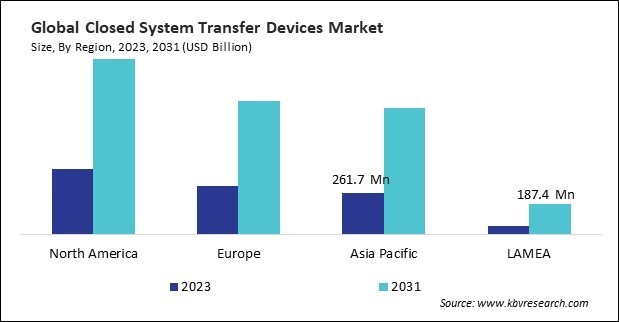According to a new report, published by KBV research, The Global Closed System Transfer Devices Market size is expected to reach $2.9 billion by 2031, rising at a market growth of 14.2% CAGR during the forecast period.
CSTDs serve multiple functions within healthcare settings, primarily ensuring the safe handling, transferring, and administering hazardous drugs. For example, one of the primary uses of CSTDs is to provide a closed system for transferring hazardous drugs from vials, ampules, or bags to syringes or infusion containers. These devices minimize the risk of spillage, aerosolization, and contamination during the transfer process, protecting healthcare workers and patients from exposure to hazardous medications. Furthermore, CSTDs facilitate the safe reconstitution of powdered medications in pharmacy compounding settings by providing a sealed environment for mixing sterile solutions.

The Needleless segment would exhibit a CAGR of 16% during (2024 - 2031). Needleless systems eliminate the need for needles during drug transfer and administration, significantly reducing the risk of needlestick injuries among healthcare workers. Needlestick injuries pose a significant occupational hazard in healthcare settings, exposing workers to the risk of bloodborne pathogens and infectious diseases. The adoption of needleless systems helps mitigate this risk, improving workplace safety and reducing the burden of needlestick-related injuries and illnesses.
The Vial access components segment is registering maximum revenue in the Global Closed System Transfer Devices Market by Component in 2023; thereby, achieving a market value of $819.5 million by 2031. Vial access components play a central role in the drug preparation process, as they facilitate the safe withdrawal of medication from vials containing hazardous drugs. These components typically include vial adapters, spikes, or membrane systems that create a sealed connection with the vial while maintaining sterility and containment. Healthcare providers rely on vial access components to ensure accurate and safe drug preparation, making them essential components of CSTDs.
The Compartmentalized devices segment would exhibit a CAGR of 15% during (2024 - 2031). Compartmentalized devices prevent drug mixing and incompatibility by keeping different components of hazardous drugs separate until the point of administration. This is particularly important for incompatible drugs or those that require separate handling due to their chemical properties or stability requirements. Compartmentalized devices ensure the integrity and efficacy of medications by preventing drug interactions or degradation.
The Luer Lock System segment is generating the highest revenue in the Global Closed System Transfer Devices Market by Closing Mechanism in 2023; thereby, achieving a market value of $960.1 million by 2031. Luer lock systems are designed to prevent accidental disconnections, leaks, and contamination during the transfer of hazardous drugs. With the increasing emphasis on safety protocols and the handling of hazardous drugs in healthcare settings, the demand for systems that offer robust containment and minimize the risk of exposure is high. Also, luer lock systems are widely recognized and standardized across the healthcare industry.
The Oncology Centers segment is experiencing a CAGR of 15.2% during (2024 - 2031). Oncology centers are primarily responsible for administering chemotherapy drugs, which are highly potent and hazardous substances. These drugs pose significant risks to both patients and healthcare workers due to their toxicity and potential for exposure. CSTDs provide a closed system for drug transfer and administration, minimizing the risk of contamination and exposure to hazardous drugs during handling.
Full Report: https://www.kbvresearch.com/closed-system-transfer-devices-market/
The North America region dominated the Global Closed System Transfer Devices Market by Region in 2023, and would continue to be a dominant market till 2031; thereby, achieving a market value of $1.1 billion by 2031. The Europe region is anticipated to grow at a CAGR of 13.8% during (2024 - 2031). Additionally, The Asia Pacific region would witness a CAGR of 15.1% during (2024 - 2031).
By Type
By Component
By Technology
By Closing Mechanism
By End User
By Geography
 Unique Offerings
Unique Offerings